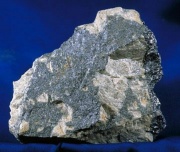Difference between revisions of "Molybdenum disulfide"
Jump to navigation
Jump to search
m (Text replace - "== Authority ==" to "== Sources Checked for Data in Record ==") |
|||
| (One intermediate revision by the same user not shown) | |||
| Line 8: | Line 8: | ||
molybdic sulfide; molybdenum sulfide; Molysulfide; Dri-Slide; molybdenite; sulfure de molybdène (Fr.); Molybdändisulfid (Deut.); Molybdänsulfid (Deut.); disulfuro de molibdeno (Esp.); sulfureto de molibdénio (Port.) | molybdic sulfide; molybdenum sulfide; Molysulfide; Dri-Slide; molybdenite; sulfure de molybdène (Fr.); Molybdändisulfid (Deut.); Molybdänsulfid (Deut.); disulfuro de molibdeno (Esp.); sulfureto de molibdénio (Port.) | ||
| + | == Applications == | ||
[[File:Molybdeniteemr2.jpg|thumb|Molybdenite (molybdenum disulfide)]] | [[File:Molybdeniteemr2.jpg|thumb|Molybdenite (molybdenum disulfide)]] | ||
| − | == | + | |
| + | == Risks == | ||
| + | |||
| + | * Toxic by inhalation. | ||
| + | * Heat or acid may cause decomposition producing hydrogen sulfide fumes. | ||
| + | * Fisher Scientific: [https://fscimage.fishersci.com/msds/84738.htm MSDS] | ||
| + | |||
| + | == Physical and Chemical Properties == | ||
Insoluble in water or dilute acids | Insoluble in water or dilute acids | ||
| Line 25: | Line 33: | ||
|- | |- | ||
! scope="row"| Melting Point | ! scope="row"| Melting Point | ||
| − | | 1185 | + | | 1185 C |
|- | |- | ||
! scope="row"| Density | ! scope="row"| Density | ||
| − | | 4.80 | + | | 4.80 g/ml |
|- | |- | ||
! scope="row"| Molecular Weight | ! scope="row"| Molecular Weight | ||
| Line 34: | Line 42: | ||
|- | |- | ||
! scope="row"| Boiling Point | ! scope="row"| Boiling Point | ||
| − | | 2375 | + | | 2375 C |
|} | |} | ||
| − | == | + | ==Resources and Citations== |
| − | |||
| − | |||
| − | |||
| − | |||
| − | |||
| − | |||
* G.S.Brady, ''Materials Handbook'', McGraw-Hill Book Co., New York, 1971 Comment: p. 470 | * G.S.Brady, ''Materials Handbook'', McGraw-Hill Book Co., New York, 1971 Comment: p. 470 | ||
Latest revision as of 11:19, 23 August 2022
Description
A fine black powder that occurs naturally as the mineral molybdenite. Molybdenum disulfide is greasy and is resistant to high temperatures and pressures. Molybdenum disulfide quickly attaches to the surface of metals to form a slick, friction resistant surface. Because of this property, it is used as a powder lubricant for machinery and moving parts, particularly in guns, weapons, and armor. However, it can corrode many metals and is not recommended for long term use.
Synonyms and Related Terms
molybdic sulfide; molybdenum sulfide; Molysulfide; Dri-Slide; molybdenite; sulfure de molybdène (Fr.); Molybdändisulfid (Deut.); Molybdänsulfid (Deut.); disulfuro de molibdeno (Esp.); sulfureto de molibdénio (Port.)
Applications
Risks
- Toxic by inhalation.
- Heat or acid may cause decomposition producing hydrogen sulfide fumes.
- Fisher Scientific: MSDS
Physical and Chemical Properties
Insoluble in water or dilute acids
| Composition | MoS2 |
|---|---|
| CAS | 1317-33-5 |
| Mohs Hardness | 1.0 |
| Melting Point | 1185 C |
| Density | 4.80 g/ml |
| Molecular Weight | mol. wt. = 160.08 |
| Boiling Point | 2375 C |
Resources and Citations
- G.S.Brady, Materials Handbook, McGraw-Hill Book Co., New York, 1971 Comment: p. 470
- Richard S. Lewis, Hawley's Condensed Chemical Dictionary, Van Nostrand Reinhold, New York, 10th ed., 1993
- Random House, Webster's Encyclopedic Unabridged Dictionary of the English Language, Grammercy Book, New York, 1997
- The Merck Index, Martha Windholz (ed.), Merck Research Labs, Rahway NJ, 10th edition, 1983 Comment: entry 6318
- The American Heritage Dictionary or Encarta, via Microsoft Bookshelf 98, Microsoft Corp., 1998
- Tom Rowland, Noel Riley, A-Z Guide to Cleaning, Conserving and Repairing Antiques, Constable and Co., Ltd., London, 1981
- Michael McCann, Artist Beware, Watson-Guptill Publications, New York City, 1979

